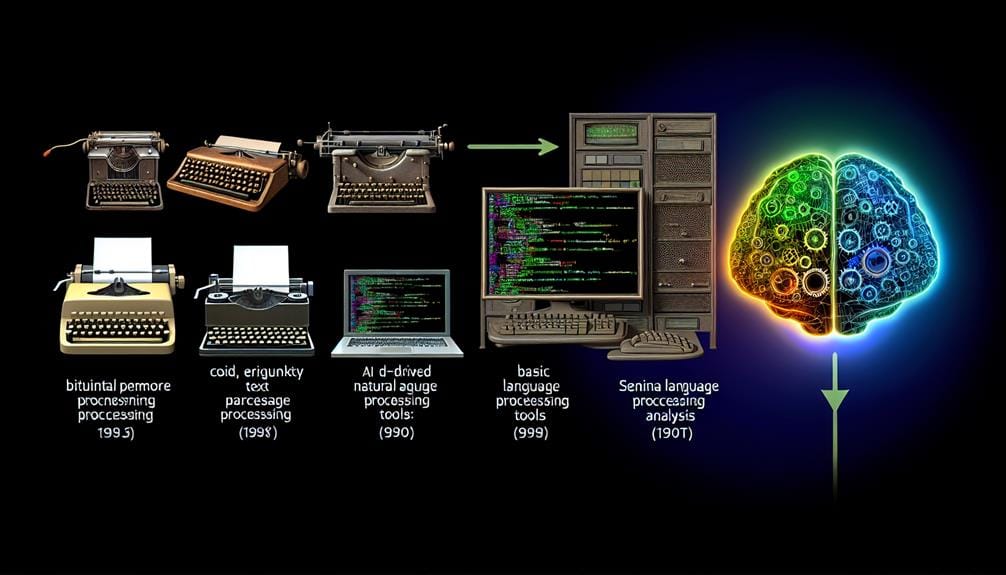You might not realize that some of the most advanced semantic NLP tools can greatly enhance your content writing by automating complex linguistic tasks. Tools like MonkeyLearn, Spacy, and Stanford CoreNLP aren't just for researchers; they're practical resources for writers aiming to improve accuracy and engagement. With features like sentiment analysis, tokenization, and syntax parsing, these tools help you produce content that's both precise and compelling. Curious about how these technologies can transform your writing process? Let's explore the key features and benefits they offer.
Key Takeaways
- GPT-4: Advanced text generation with high relevance and coherence for diverse content writing needs.
- MonkeyLearn: Extracts and transforms unstructured data, excelling in semantic content and sentiment analysis.
- Amazon Comprehend: Offers robust syntax analysis and document classification for insightful content creation.
- SpaCy: Efficiently processes large text volumes with capabilities like named entity recognition and dependency parsing.
- Stanford CoreNLP: Ensures accurate linguistic annotations and detailed document classification for refined content writing.
Evolution of NLP Tools

The evolution of NLP tools, beginning in the 1950s, has witnessed remarkable advancements, from the development of the Hidden Markov Model to the advent of large language models in 2019. Initially, the Hidden Markov Model revolutionized NLP by providing probabilistic frameworks for sequence prediction, laying the groundwork for more sophisticated techniques.
As computational power increased, deep learning emerged, enabling NLP tools to harness neural networks for intricate semantic analysis.
In recent years, transfer learning has further propelled the evolution in NLP. Large language models like GPT-3 exemplify this shift, leveraging vast datasets to pre-train models that excel in diverse tasks with minimal fine-tuning. These advancements have significantly enhanced the capabilities of Natural Language Processing Tools, making them more adept at understanding and generating human-like text.
Search engine algorithms have also benefited from these developments, integrating deep learning and semantic analysis to deliver more relevant search results. As a result, NLP tools have become indispensable in numerous applications, from content generation to advanced linguistic research.
The evolution in NLP continues to push boundaries, harnessing cutting-edge techniques to refine and expand the functionalities of modern NLP tools.
Key Features of NLP Tools
When you use NLP tools like MonkeyLearn or spaCy, you can leverage sophisticated data extraction capabilities to streamline content creation workflows.
These tools also offer robust multilingual support, ensuring thorough language processing across diverse linguistic datasets.
Data Extraction Capabilities
Modern NLP tools like MonkeyLearn and Stanford CoreNLP leverage advanced algorithms for extracting actionable insights from unstructured data sources such as emails and social media posts. These NLP tools excel in data extraction through sophisticated linguistic annotations and syntax analysis, enabling precise identification and categorization of textual elements.
For instance, Stanford CoreNLP's capabilities in parts of speech tagging and dependency parsing guarantee accurate and detailed linguistic annotations, facilitating deeper document classification and insight extraction.
When dealing with domain-specific applications, MindMeld stands out with its advanced NLP capabilities, particularly in domain understanding and video discovery via voice commands. This enables seamless interaction and efficient data retrieval from multimedia sources.
Similarly, Amazon Comprehend employs robust syntax analysis and document classification techniques, allowing for efficient and reliable data extraction from varied text formats.
Moreover, spaCy's open-source library in Python offers a streamlined approach to converting segmented text into tokenized words, optimizing the process of quick insight extraction for data analysis.
Multilingual Support
Leveraging the robust data extraction capabilities discussed, it's equally important to recognize that many NLP tools excel in providing extensive multilingual support, enhancing their utility in diverse linguistic landscapes. NLP tools like SEO.ai support over 100 languages for semantic keyword analysis, enabling precise targeting across multiple regions. HubSpot's AI writer generates copy in various languages, making it ideal for diverse platforms.
ChatGPT offers multilingual support for complex language generation tasks, allowing for seamless cross-linguistic communication. Integrated tools like GPT-4 by OpenAI facilitate advanced multilingual text generation, ensuring high-quality output irrespective of the language. Additionally, QuillBot's AI paraphrasing tool helps rewrite content in different languages, maintaining the original meaning while adapting to the target language.
| Tool | Multilingual Feature |
|---|---|
| SEO.ai | Supports 100+ languages for semantic keyword analysis |
| HubSpot AI | Generates multilingual copy for diverse platforms |
| ChatGPT | Multilingual support for language generation tasks |
| GPT-4 | Integrated into various tools for advanced multilingual text generation |
| QuillBot | Assists in rewriting content across different languages |
These capabilities highlight the sophistication of NLP tools in managing multilingual tasks, ensuring that content creation is both efficient and adaptable to global audiences. This multilingual support is pivotal for businesses aiming to expand their reach and engage with a broader demographic.
MonkeyLearn Overview

Frequently utilized in data-driven environments, MonkeyLearn is an AI-powered tool designed to extract and transform unstructured data from multiple sources into actionable visual insights. Using advanced Natural Language Processing (NLP) techniques, MonkeyLearn excels in semantic content analysis and sentiment analysis.
You'll find that its user-friendly interface simplifies complex data analysis tasks, enabling efficient insight extraction without necessitating extensive coding knowledge.
MonkeyLearn's capabilities extend to extracting data from diverse sources such as Gmail, tweets, and various text formats. By leveraging AI, it processes this data to perform tasks like topic classification and sentiment analysis, offering you a thorough analytical overview.
The platform's design ensures you can generate detailed visualizations, which are essential for interpreting data trends and patterns effectively.
Moreover, MonkeyLearn provides extensive tutorials and sample templates, streamlining your onboarding process and making sure you can utilize its vast feature set with ease. This makes it an invaluable tool for content writers who need to analyze large volumes of text data quickly and accurately.
Whether you're looking to gauge public sentiment or classify topics, MonkeyLearn offers robust solutions for all your semantic analysis needs.
Spacy Capabilities
Following the versatile functionalities of MonkeyLearn, you'll find Spacy to be an indispensable open-source Python library for advanced Natural Language Processing tasks, excelling in tokenization, part-of-speech tagging, named entity recognition, and dependency parsing. Spacy's speed and efficiency render it particularly effective for processing large volumes of text data, making it a favorite among developers and researchers.
Spacy offers several compelling features:
- Tokenization: Efficiently segments text into individual tokens, facilitating downstream NLP tasks.
- Part-of-Speech Tagging: Accurately assigns grammatical categories to each token, enhancing syntactic analysis.
- Named Entity Recognition: Identifies and classifies entities such as names, dates, and locations within text, essential for information extraction.
- Dependency Parsing: Analyzes syntactic structure by establishing relationships between words, enabling deep linguistic understanding.
Spacy's pre-trained models support multiple languages, ensuring broad applicability across different linguistic contexts. Additionally, its customization capabilities allow you to fine-tune models to meet specific project requirements, thereby enhancing accuracy and relevance.
The combination of robust features and adaptability makes Spacy an essential tool in NLP workflows, providing a solid foundation for complex text processing and analysis tasks. Integrate Spacy into your pipeline to leverage its advanced functionalities and elevate your content writing endeavors.
Stanford CoreNLP Highlights

You'll find Stanford CoreNLP's linguistic annotation capabilities indispensable for tasks requiring part-of-speech tagging and named entity recognition.
Its multilingual support, spanning eight languages, enhances its utility in diverse linguistic contexts.
Plus, the tool's customization and flexibility allow you to tailor it to specific content writing needs, ensuring peak performance.
Linguistic Annotation Capabilities
Leveraging Stanford CoreNLP's linguistic annotation capabilities, you can achieve precise part-of-speech tagging and named entity recognition for a thorough text analysis. This tool is essential for Natural Language Processing (NLP) tasks, providing detailed linguistic annotations that enhance text understanding.
With Stanford CoreNLP, you gain a customizable tool that adapts to your specific semantic NLP needs, ensuring accurate language analysis.
Stanford CoreNLP excels in several key areas:
- Part-of-speech tagging: Accurately identifies grammatical categories for each word, facilitating refined syntactic analysis.
- Named entity recognition: Detects and classifies entities such as names, dates, and locations, essential for extracting meaningful information.
- Syntactic dependency labeling: Maps out the grammatical structure of sentences, allowing for in-depth linguistic analysis.
- Customizable tool: Offers flexibility to tailor annotations and processing pipelines to specific NLP requirements.
Multilingual Support Features
Stanford CoreNLP's multilingual support empowers you to conduct NLP analysis in eight different languages, guaranteeing thorough linguistic annotations and parts-of-speech tagging across diverse linguistic datasets. Leveraging this tool, you can execute complex multilingual NLP analysis with precision, as it offers robust support for key languages including English, Chinese, French, German, and Spanish.
The platform excels in providing detailed linguistic annotations, facilitating accurate parts-of-speech identification, which is essential for nuanced text analysis. It stands out due to its robust support for various syntactic and semantic tasks, making it an indispensable tool for multilingual language processing. This versatility ensures that you can handle diverse linguistic datasets efficiently, enhancing both the breadth and depth of your NLP tasks.
Stanford CoreNLP's customizable nature allows you to tweak its functionalities to meet specific language processing requirements, making it a versatile platform capable of adapting to different linguistic challenges. This adaptability is further complemented by its strong emphasis on maintaining high precision and reliability in multilingual text analysis, ensuring consistent and accurate results across languages.
Ultimately, Stanford CoreNLP's multilingual capabilities make it a powerful tool for any content writing that demands sophisticated language processing and detailed text analysis.
Customization and Flexibility
CoreNLP's extensive customization options enable you to fine-tune its Java-based language analysis tools to meet specific NLP requirements, ensuring precise linguistic annotations and parts-of-speech identification. This adaptability makes Stanford CoreNLP an indispensable asset for any content writer needing robust, customizable NLP tools.
The platform's flexibility and adaptability are vital for diverse applications. You can tailor CoreNLP to your needs through its modular architecture and customizable pipelines.
Here's how you can leverage CoreNLP:
- Customizable Pipelines: Configure pipelines to include only the linguistic annotations you need, optimizing processing speed and resource usage.
- Fine-Grained Control: Adjust the granularity of parts-of-speech identification to suit specific linguistic contexts, enhancing the accuracy of syntactic parsing.
- Extensible Framework: Integrate custom annotators and classifiers, allowing you to extend the core functionality to handle specialized language phenomena.
- Multi-Language Support: Utilize its support for 8 natural languages to address multilingual content requirements effectively.
MindMeld Applications
Although primarily designed for domain understanding, MindMeld enables you to build sophisticated conversational interfaces by leveraging its advanced NLP, Question Answering, and Dialog Management capabilities.
By harnessing the power of Natural Language Processing, MindMeld facilitates the creation of custom knowledge bases, ensuring a more nuanced and context-aware user interaction. The platform's Question Answering system is optimized for rapid retrieval and accurate responses, enhancing user satisfaction.
MindMeld's Dialog Management system is engineered for seamless conversation flows, reducing friction in user interactions. This is pivotal for applications requiring intricate conversational patterns and complex query handling.
The integration of voice commands allows for intuitive video discovery, making content navigation more efficient. This feature is particularly beneficial for multimedia platforms seeking to improve user engagement through voice-activated controls.
As a free-to-use tool, MindMeld democratizes access to cutting-edge semantic NLP technologies, enabling developers and content creators to implement high-level functionalities without significant financial barriers. Its robust architecture supports a wide range of applications, from customer service bots to interactive learning modules.
MindMeld's versatility and advanced NLP capabilities make it an indispensable tool in the field of semantic NLP for content writing.
Amazon Comprehend Insights

Amazon Comprehend Insights, leveraging advanced machine learning algorithms, offers powerful syntax analysis and document classification capabilities for intricate NLP tasks. When you're dealing with large volumes of unstructured text data, Amazon Comprehend Insights can be an essential tool, providing actionable insights that drive decision-making processes.
By utilizing Amazon Comprehend Insights, you gain access to:
- Syntax Analysis: Break down sentences to understand the role and relationship of each word, enhancing your content's linguistic structure.
- Document Classification: Automatically categorize documents based on predefined criteria, streamlining your data organization efforts.
- Multilingual Support: Process text in multiple languages, making it ideal for global applications and diverse datasets.
- Custom Applications Integration: Seamlessly integrate with AWS Services, allowing you to build tailored solutions that meet specific business needs.
The cost-effective nature of Amazon Comprehend Insights, with a training cost of just $3 per hour, ensures you're getting robust NLP capabilities without breaking the bank. Its ability to handle complex NLP tasks while providing real-time, actionable insights makes it an essential tool for any content writer or data scientist looking to leverage the full potential of text data.
Whether you're developing custom applications or integrating with existing AWS Services, Amazon Comprehend Insights stands out as a versatile and reliable option.
OpenAI Utilization
Harnessing the power of OpenAI's cutting-edge language models like GPT-3 and GPT-4, you can elevate your content writing by generating contextually rich and coherent text with unprecedented precision. These AI content writing tools utilize advanced deep learning techniques to produce human-like text, transforming traditional writing processes.
OpenAI's GPT-3 model, encompassing 175 billion parameters, is a paradigm shift in text generation. It leverages vast datasets to understand context, syntax, and semantics, offering unparalleled language capabilities. This allows you to create high-quality content that's both relevant and fluid, maintaining coherence across diverse topics.
The GPT-4 model, representing the latest in OpenAI's advancements, further refines these capabilities. With enhanced deep learning algorithms and an even larger parameter set, GPT-4 provides superior text generation, ensuring your content isn't only accurate but also engaging. These enhancements boost writing efficiency, reducing the time and effort required to produce top-tier content.
Integrating OpenAI's language models into your workflow can revolutionize your writing tasks. By automating mundane aspects of content creation, these tools free up your cognitive resources, allowing you to focus on higher-level editorial and creative tasks. This symbiotic relationship between AI and writer optimizes productivity and content quality.
Microsoft Azure Benefits

By utilizing Microsoft Azure's extensive capabilities, you can greatly enhance your content writing process with advanced NLP functionalities and seamless scalability. Leveraging Azure's text generation and language understanding features, your content creation becomes more efficient and precise. This AI tool empowers you to generate high-quality text and understand intricate language patterns, guaranteeing your content meets rigorous standards.
Azure's cloud storage offers cost-effective solutions, providing a $200 credit for 12 months, which is particularly beneficial for managing large volumes of data necessary for content creation. Its automated scalability ensures that your resources dynamically adjust to your workload, maintaining peak performance without manual intervention.
Furthermore, Azure facilitates seamless collaboration, allowing multiple users to work on projects simultaneously without compromising data integrity.
Here's how Azure benefits your content writing process:
- Advanced NLP Functionalities: Enhance your content with sophisticated text generation and language understanding capabilities.
- Cost-Effective Cloud Storage: Utilize affordable storage solutions with substantial credits to manage extensive data.
- Automated Scalability: Experience dynamic resource allocation that adapts to your needs, optimizing performance.
- Seamless Collaboration: Enable multiple users to collaborate efficiently on content projects in real-time.
Harnessing Microsoft Azure's powerful tools can greatly optimize your content creation workflow, ensuring high-quality outputs with minimal effort.
Google Cloud Functions
You can leverage Google Cloud Functions for serverless computing, eliminating the need to manage infrastructure while deploying single-purpose functions.
This platform's automatic scaling capability guarantees your event-driven functions handle varying loads efficiently, optimizing resource usage.
With support for multiple programming languages, it offers flexibility and cost-effectiveness, as you're billed solely for function execution time.
Serverless Computing Benefits
Leveraging Google Cloud Functions, you'll experience unparalleled serverless computing benefits that eliminate the need for server management and optimize cost efficiency by charging only for actual compute time used. This model provides substantial cost savings and inherent scalability, guaranteeing your applications are both efficient and robust.
Cost Efficiency:
With Google Cloud Functions, you only pay for the compute time consumed by your functions, resulting in significant cost savings compared to traditional server-based models.
Scalability:
Automatic scaling capabilities make sure that your serverless applications can handle fluctuating workloads seamlessly without manual intervention.
Programming Languages Support:
Google Cloud Functions supports multiple programming languages, including Node.js, Python, and Go, providing flexibility and ease of development.
Integration with Google Cloud Services:
Seamless integration with other Google Cloud services enhances the development and deployment process, allowing for a more cohesive serverless application environment.
Scalable Event-Driven Functions
Harnessing Google Cloud Functions, developers can effortlessly deploy scalable event-driven functions that automatically adjust resources to match incoming events, ensuring peak performance and efficiency. By leveraging automatic scaling, you can handle varying workloads without manual intervention, making it ideal for applications involving Natural Language Processing (NLP) Tools.
Google Cloud Functions supports multiple languages, including Node.js and Python, allowing you to write functions that understand semantic relationships and context. This capability is essential for NLP tools aiming to improve search engine rankings. For instance, you can create functions that analyze text, extract key phrases, and determine sentiment—all without managing servers.
| Feature | Benefit |
|---|---|
| Automatic Scaling | Matches resources to event demand |
| Multi-language Support | Write functions in Node.js, Python, etc. |
| Seamless GCP Integration | Streamlined workflows |
Google Cloud Functions also integrate seamlessly with other GCP services, enabling a streamlined workflow. For instance, you can easily connect to BigQuery for data analysis or Cloud Storage for file handling. Additionally, the pay-as-you-go pricing model ensures you only pay for the resources consumed, optimizing cost-efficiency.
Conclusion
In leveraging top semantic NLP tools like MonkeyLearn, Spacy, and Stanford CoreNLP, you're not just polishing content; you're turning linguistic complexity into a well-oiled machine.
These tools streamline tokenization, sentiment analysis, and syntactic parsing, transforming raw text into insightful data.
With Amazon Comprehend, OpenAI, Microsoft Azure, and Google Cloud, you've got a powerhouse of options to refine your content strategies, ensuring your narratives are analytically robust and semantically precise.


